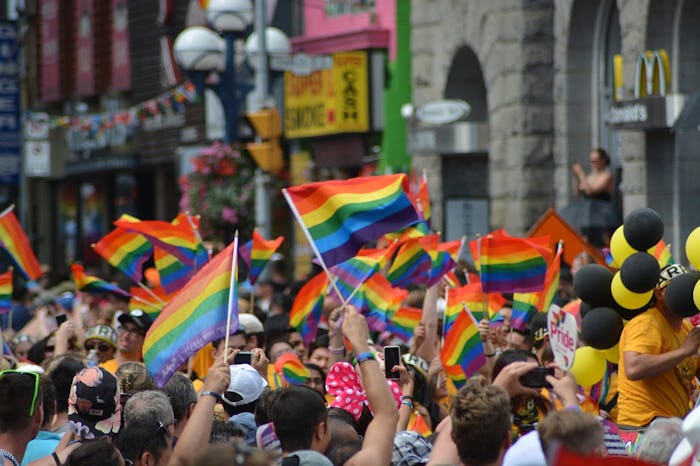June is now known as Lesbian, Gay, Bisexual, and Transgender (LGBT) Pride Month. Throughout the month, there will be Pride parades held in many major cities and rainbow flags displayed more prominently than ever. But have you ever stopped to wonder why is the rainbow flag a symbol for gay pride? Or even think about what the rainbow or each color may potentially represent?
According to Carnegie Mellon University (CMU), San Francisco resident, artist, and drag queen Gilbert Baker created the rainbow flag symbol in 1978. However, it's not the one we know today. According to Artsy, Baker's original rainbow flag contained eight stripes — pink, red, orange, yellow, green, turquoise, blue, and purple, in that order — with each color standing for something. As Artsy further explained:
- Pink represented sexuality.
- Red represented life.
- Orange represented healing.
- Yellow represented sunlight
- Green represented nature.
- Turquoise represented magic.
- Blue represetned peace.
- Purple represented spirit.
A few years later, however, Baker decided to reduce the colors from eight to six. This was primarily because he wanted a consistent representation of the flags. Because pink and turquoise fabrics were expensive, this was a better way to ensure others could freely recreate the flags to express themselves, according to Artsy.
Moving forward, the aforementioned CMU article shared the rainbow flag contained six stripes representing the six colors of the rainbow. This flag eventually replaced the pink triangle symbol as a more encompassing and positive approach to Pride. (For those who are unfamiliar, the SUNY Geneseo website noted that the pink triangle is rooted in the World War II era and was used by Nazis to identify members of the gay community.)
Additionally, in 1989, the rainbow flag got a nationwide boost of attention when John Stout sued and won a case against his landlords who'd banned the display of the flag outside his home, according to the Los Angeles Times. This was a major step and part of the movement to recognition for the LGBT community. Today, the rainbow flag is even recognized by the International Congress of Flag Makers.
The reason behind Baker's original design for the rainbow flag, however, really focused on Baker's drive to create something the LGBT community could use to "communicate beauty, diversity, and power," according to the aforementioned CMU article. Additionally, The Washington Post noted that, because the rainbow is a natural symbol, it can speak to any person, of any language.
As the LGBTQ community continues to have its rights threatened or demeaned, the rainbow flag still holds true in its representation. And it will continue to remain an important part of fighting back, speaking up, and representing the diversity within communities across the world.
